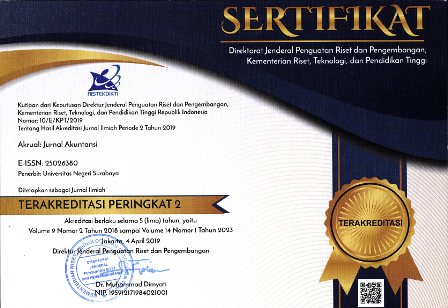Disharmoni Sistem Informasi Akuntansi Penerimaan dan Piutang Dengan Proses Bisnis Kepabeanan
DOI:
https://doi.org/10.26740/jaj.v9n1.p20-40Keywords:
Bea Cukai, Penerimaan, SAPP, Proses Bisnis, KepabeananAbstract
Tujuan penelitian ini adalah mengeksplor keselarasan sistem informasi akuntansi dengan proses bisnis di Direktorat Jenderal Bea dan Cukai untuk menghasilkan nilai penerimaan dan piutang yang handal. Metode penelitian menggunakan metode kualitatif dengan pendekatan eksploratif. Teknik analisis menggunakan pendekatan wawancara, observasi, dokumen, rekaman arsip dengan melihat dari aspek pengendalian input, proses, dan output. Hasil penelitian menunjukkan adanya ketidakselarasan antara sistem informasi akuntansi penerimaan dan piutang dengan proses bisnis kepabeanan. Keduanya berjalan terpisah dimana sistem yang dibangun untuk keperluan akuntansi dan proses bisnis berbeda. CEISA sebagai sistem komputerisasi pelayanan, tidak terhubung dengan sistem penerimaan. Padahal DJBC selain melayani pengguna jasa, juga harus mengamankan penerimaan negara. Selain itu, proses validasi penerimaan Sistem Akuntansi Umum yang lama mempersulit DJBC dalam meyakini validitas penerimaan yang tercatat dalam Sistem Akuntansi Instansi. Terkait piutang, seluruh penerbitan dokumen piutang belum melalui Sistem Aplikasi Piutang dan Pengembalian (SAPP). Selain itu, SAPP juga tidak dapat digunakan langsung sebagai laporan piutang.
References
Abdallah, J., & Adel, A. 2013. The Impact of Using Accounting Information Systems on The Quality of Financial Statements Submitted to The Income and Sales Tax Department in Jordan. European Scientific Journal. Terdapat pada:https://eujournal.org/index.php/esj/article/view/2264
Ada, ?., & Ghaffarzadeh, M. 2015. Decision Making Based on Management Information System and Decision Support System. Journal for Studies in Management and Planning, 1(3), 206-217.https://doi.org/10.13187/er.2015.93.260
Bell, T. B., Knechel, W. R., Payne, J. L., & Willingham, J. J. 1998. An Empirical Investigation of the Relationship Between the Computerization of Accounting Systems and the Incidence and Size of Audit Differences. Auditing: A Journal of Practice & Theory, 17(1), 13-38.
Bisbal, J., Lawless, D., Wu, B., & Grimson, J. 1999. Legacy Information Systems: Issues and Directions. IEEE software, 16(5), 103. terdapat pada: http://ieeexplore.ieee.org/document/795108/
Burks, J. J. 2015. Accounting Errors in Nonprofit Organizations. Accounting Horizons, 29(2), 341-361. DOI: https://doi.org/10.2308/acch-51017
Cong, Y., & Romero, J. 2013. On Information Systems Complexity and Vulnerability. Journal of Information Systems, 27(2), 51. https://doi.org/10.2308/isys-50562
Cram, W. A., & Gallupe, R. B. 2016. A Method to Evaluate Information Systems Control Alignment. Journal of Information Systems, 30(1), 117-135. https://doi.org/10.2308/isys-51297
Elliott, R. K. 1992. The Third Wave Breaks on The Shores of Accounting. Accounting Horizons, 6(2), 61.
Florin-Constantin, D. (2013). The Users of Accounting Information and Their Needs, Timisoara.
Ghasemi, M., Shafeiepour, V., Aslani, M., & Barvayeh, E. 2011. The Impact of Information Technology (IT) on Modern Accounting Systems. Procedia - Social and Behavioral Sciences, 28, 112-116. https://doi.org/10.1016/j.sbspro.2011.11.023
Gheorghe, D. 2012. The Accounting Information Quality Concept. Economics, Management and Financial Markets, 7(4), 326-336.
Terdapat pada: http://econpapers.repec.org
Granlund, M. 2011. Extending AIS Research to Management Accounting and Control Issues: A Research Note. International Journal of Accounting Information Systems, 12(1), 3-19. DOI: https://doi.org/10.1016/j.accinf.2010.11.001
Grant, G. H., Miller, K. C., & Alali, F. 2008. The Effect of IT Controls on Financial Reporting. Managerial Auditing Journal, 23(8), 803-823.
DOI: https://doi.org/10.1108/02686900810899536
Huang, S.-M., Yen, D. C., Hung, Y.-C., Zhou, Y.-J., & Hua, J.-S. 2009. A Business Process Gap Detecting Mechanism Between Information System Process Flow and Internal Control Flow. Decision Support Systems, 47(4), 436-454. DOI: https://doi.org/10.1016/j.dss.2009.04.011
Lim, F. P. C. 2013. Impact of Information Technology on Accounting Systems. Asia-Pasific Jornal of Multimedia Services Convergent with Art, Humanities and Socialgy, 3(2), 93-106.
DOI:https://doi.org/10.14257/ajmscahs.2013.12.02
Maharsi, S. 2000. Pengaruh Perkembangan Teknologi Informasi Terhadap Bidang Akuntansi Manajemen. Jurnal Akuntansi & Keuangan, 2(2), 127-137. Terdapat pada: http://puslit.petra.ac.id/journals/accounting/
Moorthy, M. K., Voon, O. O., Samsuri, C. A. S. B., Gopalan, M., & Yew, K.-T. 2012. Application of Information Technology in Management Accounting Decision Making. International Journal of Academic Research in Business and Social Sciences, 2(3), 1. Terdapat pada: hrmars.com/index.php/pages/detail/IJARBSS
Newcomer, K. E., & Caudle, S. L. 1991. Evaluating Public Sector Information Systems: More Than Meets the Eye. Public Administration Review, 51(5), 377-384. DOI:https://doi.org/10.2307/976406
O'Donnell, E., & David, J. S. 2000. How Information Systems Influence User Decisions: A Research Framework and Literature Review. International Journal of Accounting Information Systems, 1(3), 178-203. https://doi.org/10.1016/s1467-0895(00)00009-9
Patasiene, I., Zaukas, G., & Patasius, M. 2015. Integration of Business Game for Improving Literacy of Accounting Information Systems. Procedia - Social and Behavioral Sciences, 213, 304-308.
https://doi.org/10.1016/j.sbspro.2015.11.542
Peraturan Menteri Keuangan. (2015). Peraturan Menteri Keuangan Nomor 234/PMK.01/2015 tentang Organisasi dan Tata Kerja Kementerian Keuangan. Terdapat pada:www.jdih.kemenkeu.go.id
Ramli, I., & Iskandar, D. 2014. Control Authority, Business Strategy, and the Characteristics of Management Accounting Information Systems. Procedia - Social and Behavioral Sciences, 164, 384-390. https://doi.org/10.1016/j.sbspro.2014.11.092
Sonnenberg, C., & Jan vom, B. 2014. The Missing Link Between BPM and Accounting. Business Process Management Journal, 20(2), 213-246. https://doi.org/10.1108/bpmj-12-2012-0136
Sugiyono. 2016. Memahami Penelitian Kualitatif. Bandung: Alfabeta.
Surendro, K. 2007. Pemanfaatan Enterprise Architecture Planning untuk Perencanaan Strategis Sistem Informasi. Jurnal Informatika, 8(1), 1-9. Terdapat pada: jurnalinformatika.petra.ac.id
Downloads
Published
How to Cite
Issue
Section
 Abstract views: 1448
,
Abstract views: 1448
, PDF Downloads: 1035
PDF Downloads: 1035


















